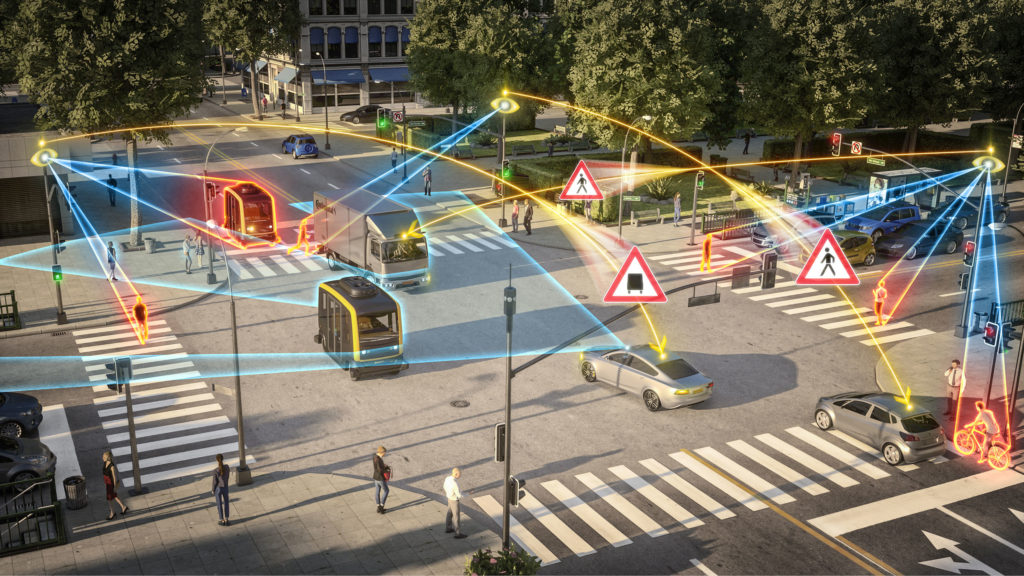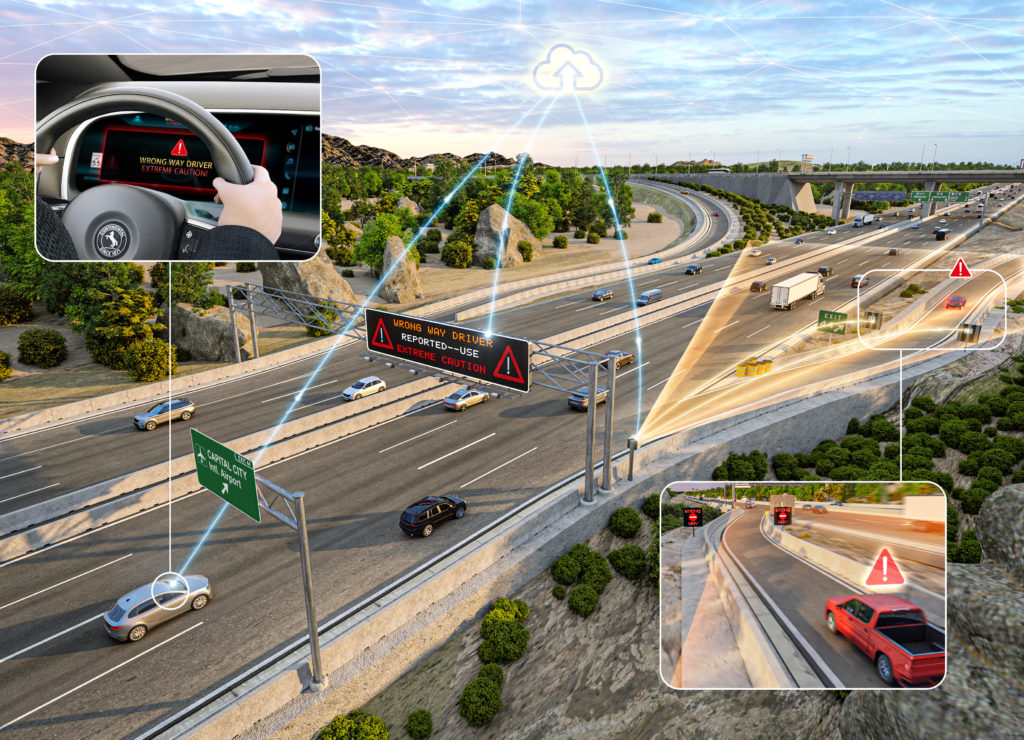
Preventing crashes with V2X, I2X: ABI predicts ‘cooperative mobility’; Continental’s Mich. hub
By onAnnouncements | Market Trends | Technology
ABI Research on Thursday announced its prediction that connected cars would share more information with each other this year in more “cooperative forms of mobility.”
We’ve been focusing on the idea of connected cars (or devices within cars like smartphones and dongles) contacting OEMs and insurers at the moment of a crash, which clearly has ramifications on collision industry business and marketing models.
But repairers shouldn’t ignore the effect advances in “V2X” — “vehicle to everything” — connected communications paired with vehicle sensors could also have on crash volume.
A car could alert another vehicles that “I’m about to intersect your travel path” or “there’s a hazard ahead,” resulting in fewer collisions. It could also alert a third-party aggregator such as Waze or a Department of Transportation, which could in turn disseminate that information to a larger audience through in-vehicle communications or something as simple as a text alert.
Or the infrastructure itself could alert the vehicle, such as an intersection telling a connected car that the light is red or a pedestrian is coming and to act accordingly.
Connectivity and coordination
According to ABI, motorists should expect more of this sort of thing in this new year.
“Driving is a multi-agent problem, with many of today’s accidents and inefficiencies due to poor communication and coordination between the various road users,” ABI Research wrote in its new white paper putting “Cooperative Mobility” among 35 trends to watch this year. “The year 2020 will see the advent of more cooperative forms of mobility, with connected cars on the road starting to share data messages about road and traffic conditions to allow other connected vehicles to anticipate hazards and improve traffic flow.
“The first phase will take the form of low-bandwidth, high-latency communication via the Long-Term Evolution (LTE) network between connected cars and data ingestion platforms to enable applications like ice and oil hazard warnings and lane-level traffic assistance. The year 2020 will see millions of connected cars deployed that both contribute data to these ingestion platforms and take advantage of the services that they enable.
“The year 2020 will also see the first large-scale deployment of 802.11p V2X technology on the Volkswagen Golf in Europe, a model that typically ships in volumes of 450,000+ every year. This will enable low-bandwidth and low-latency broadcast communications between a growing number of connected cars to enable safety-critical collision avoidance.”
Smart infrastructure
Continental also recently announced some interesting work along these lines, a “Wrong-Way Driver (WWD) detection system,” and two “Intelligent Intersections” within an Auburn Hills, Mich., “Smart City Mobility and Transportation Hub.”
“Auburn Hills is excited to partner with Continental to provide a real-world test location for Smart City Technology that will make the future of transportation safer not only for motorists, but cyclists, pedestrians, and other users within the confluence of the intersection,” Auburn Hills Mayor Kevin McDaniel said in a statement.
Continental in a Dec. 18, 2019, news release said it outfitted the infrastructure at the hub with the short- and long-range radars it had been placing on vehicles for advanced driver assistance systems.
“Continental now looks to apply the economies of scale together with its software functions know-how from automotive to the infrastructure,” Continental wrote in a news release.
According to Continental North America chassis and safety systems and technology director Jeremy McClain, more than 43 percent of collisions occur at intersections.
“Ultimately, this (intelligent intersection) technology will have the potential to improve traffic flow, add convenience, reduce pollution and, most importantly, significantly increase the intersection’s safety by communicating hidden dangers to approaching connected vehicles and pedestrians,” Continental wrote in a news release of its project.
It described the system for now as getting the lay of the land of the intersections.
“In its current phase, the Smart City Mobility and Transportation Hub is collecting important non-personally identifiable information, like location and movement patterns, about pedestrians, vehicles and other intersection-related activity to create an environment model needed for infrastructure-to-everything (I2X) communication,” Continental wrote. “The environment model provides information about traffic participants (i.e., vehicles and vulnerable road users), traffic infrastructure, static objects and the overall road situation to connected vehicles.”
Continental suggested a setup like Auburn Hills’ could aid society besides preventing crashes.
“This combination can offer a number of benefits, like counting the number of vehicles entering and exiting a specific zone to communicate the number of available parking spaces to interested vehicles,” Continental wrote. “By connecting to a traffic light controller, traffic flow can be better optimized, reducing not only congestion, but also emissions from idling vehicles. The solution makes it possible to warn an approaching vehicle about occluded hazards such as pedestrians. With additional analysis and artificial intelligence, intention prediction of pedestrians becomes possible, helping to alert drivers to pedestrians planning to cross even when the vehicle has the right of way.”
Continental said it also has intelligent intersections in Columbus, Ohio, and Walnut Creek, Calif., and “plans to expand to other cities in the near future.”
The wrong-way driver system installed in Auburn Hills also sounds fairly doable from a technology and expense perspective.
“Unlike other solutions on the market, Continental’s WWD detection system relies heavily on its premium automotive-grade radar sensors to detect wrong-way drivers,” Continental wrote in a news The detection technology uses a combination of Continental sensors, connected-vehicle systems and a heatmapping algorithm. The self-learning system automatically defines the roadways and directions of travel, then sends an alert via push notification to a mobile device or connected vehicle informing at-risk vehicles of the wrong-way driver’s location, speed and direction of travel.”
Continental proposes sticking the technology in a unit “with low power requirements, making it suitable for solar power” and placed on existing poles and other fixtures near off-ramps. This would allow for “detecting and alerting of wrong-way drivers just entering the highway, but also those who may have entered several miles before,” Continental wrote. It would send messages to authorities and other drivers — including through SMS text messages.
“(I)t could potentially be integrated into widely used navigation apps, increasing penetration and effectiveness,” Continental wrote.
Only 295 wrong-way crashes occur on average in the U.S., but the odds favor someone dying each time one occurs. Those less than 300 annual wrong-way collisions produce an average of 389 fatalities, according to the Tier 1 supplier.
No autonomy this year?
The ABI Research whitepaper also flagged 19 trends it called buzzy but “look less likely to move the needle over the next twelve months.” According to the firm, the whole idea of nobody dying in crashes and Level 4 autonomy won’t happen this year after all.
“At one point, 2020 seemed a distant target, a long-term horizon over which the technology trends that have dominated the automotive scene for the last 10 years—electrification, connectivity, autonomous driving—would all have harmonized to deliver safer, more efficient transportation for all. Indeed, there was good reason for optimism. Complementary Metal-Oxide-Semiconductor (CMOS) image cameras made Advanced Driver-Assistance Systems (ADAS) affordable, DL approaches and powerful computing made Autonomous Vehicle (AV) software development seem feasible, Tesla showed that connectivity meant more for automotive than eCall and traffic services, and Uber gave hope of a transportation future free from widespread car ownership.
“In spite of this, the world goes into 2020 with road accident casualties increasing, OEM spending on autonomous technologies contracting, connectivity enabling the same legacy infotainment applications, and ride hailing operations facing serious questions over profitability. The CASE overall vision remains compelling, and most OEMs are staying the course, targeting 2025 or 2030 for the transition to connected, autonomous, and electrified mobility. How can the industry avoid missing the mark again? The focus must shift from the broad strokes vision, compelling as it may be, to the pain points that hold back implementation: how can the safety of an autonomous system be demonstrated to regulators, how can smart-charging approaches enable Electric Vehicle (EV) deployment without overwhelming the last mile of power distribution, and how can the Intelligent Vehicle Network (IVN) be sustainably redesigned to maximize the value of connected and software-defined cars?”
The idea of saving lives with connected infrastructure rather than waiting around for autonomy or even vehicle-to-vehicle communications also arose at last summer’s Center for Automotive Research Management and Briefing Seminars.
Sue Bai, chief engineer in Honda R&D Americas’ automobile technology research, pointed out that a single traffic light offering essential information about the road could allow an OEM’s customer to benefit immediately, even if vehicle-to-vehicle communications hadn’t matured yet.
More information:
“2020 Will be the Year of Cooperative Mobility via the Connected Car”
ABI Research, Jan. 2, 2020
“Continental Launches Smart City Mobility and Transportation Hub for Safer and Smarter Cities”
Continental, Dec. 18, 2019
“54 Technology Trends to Watch in 2020”
ABI Research, 2019
Images:
Continental on Dec. 18, 2019, announced it had set up two “Intelligent Intersections” within an Auburn Hills, Mich., “Smart City Mobility and Transportation Hub.” (Provided by Continental)
Continental on Dec. 18, 2019, announced its Auburn Hills, Mich., “Smart City Mobility and Transportation Hub” contained technology to detect wrong-way drivers. (Provided by Continental)


